Easy New Orleans Bread Pudding Recipe: A Cozy Classic Treat
Nestled in the heart of classic New Orleans bread pudding lies a sweet symphony of comfort and tradition.
Generations of home cooks have perfected this delectable dessert with whispers of southern charm.
Warm vanilla and rich custard create a magical backdrop for rustic bread cubes.
Cinnamon and nutmeg dance through each tender bite, promising pure indulgence.
Local bakeries and grandmothers have long guarded their secret techniques for achieving that perfect, silky texture.
Bourbon-spiked sauce adds a bold twist that makes this dessert unforgettable.
Let your taste buds journey through the sultry streets of New Orleans with this irresistible treat.
Why Classic New Orleans Bread Pudding Stands Out
Must-Have Ingredients for Classic New Orleans Bread Pudding
Main Ingredients:Sweet Enhancers:Spice Blend:Additional Components:How to Bake Classic New Orleans Bread Pudding Flawlessly
Step 1: Warm Up the Oven
Crank the oven to a toasty 350F (175C) and generously coat a 9×13-inch baking dish with butter or cooking spray to prevent sticking.
Step 2: Create a Bread Foundation
Scatter bread cubes evenly across the greased dish.
Sprinkle raisins over the bread if you’re craving that extra burst of sweetness.
Step 3: Whip Up a Creamy Custard
In a large mixing bowl, blend together:Whisk these ingredients until they transform into a silky, smooth mixture.
Step 4: Soak the Bread
Pour the luscious custard over the bread cubes, gently pressing down to ensure every morsel gets drenched in the creamy goodness.
Step 5: Add Buttery Richness
Drizzle melted butter evenly across the top, creating a golden, decadent layer.
Step 6: Let the Magic Happen
Allow the bread to sit and soak up the custard for about 15 minutes, letting the flavors mingle and develop.
Step 7: Bake to Perfection
Slide the dish into the preheated oven and bake for 40-45 minutes.
You’ll know it’s ready when the pudding sets and the top turns a beautiful golden brown.
Step 8: Serve and Enjoy
Pull the pudding from the oven and let it cool slightly.
For an extra indulgent touch, drizzle with warm bourbon sauce before serving.
Handy Tips for Classic New Orleans Bread Pudding Success
Unique Twists on Classic New Orleans Bread Pudding to Try
Perfect Pairings for Classic New Orleans Bread Pudding
How to Keep Classic New Orleans Bread Pudding Fresh
FAQs
Day-old French bread or brioche are ideal because they absorb the custard perfectly and provide a rich, soft texture without falling apart.
Absolutely! You can omit raisins or substitute with other mix-ins like chocolate chips, pecans, or dried cranberries to customize the flavor.
No, this recipe is quite simple. The key steps are cutting bread, mixing custard ingredients, and allowing bread to soak before baking. Even novice bakers can successfully create this classic dessert.
Print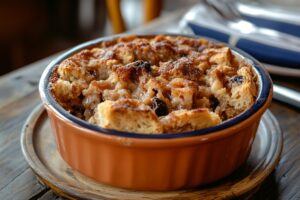
Classic New Orleans Bread Pudding Recipe
- Total Time: 1 hour 5 minutes
- Yield: 8 1x
Description
Indulgent New Orleans Bread Pudding whisks classic Southern comfort into a creamy, bourbon-kissed dessert that dances with rich caramel notes. Warm vanilla sauce and candied pecans complete this irresistible southern treat you’ll savor to the last delightful spoonful.
Ingredients
Main Ingredients:
- 6 cups (1.4 kg) day-old French or brioche bread, cubed
- 4 large eggs
- 2 cups (473 ml) milk
- 1 cup (237 ml) heavy cream
- 1 cup (200 g) granulated sugar
Spices and Flavoring:
- 1 teaspoon vanilla extract
- 1 teaspoon ground cinnamon
- 1/2 teaspoon ground nutmeg
- 1/4 teaspoon salt
Additional Ingredients:
- 1 cup (150 g) raisins
- 2 tablespoons (30 ml) butter, melted
Instructions
- Arrange bread cubes uniformly in a greased 9×13-inch baking vessel, generously scattering raisins across the surface.
- Craft a luxurious custard by whisking milk, cream, eggs, sugar, vanilla, cinnamon, nutmeg, and salt until achieving a silky, homogeneous texture.
- Gently cascade the custard over bread cubes, tenderly pressing to ensure complete liquid absorption.
- Drizzle melted butter evenly, creating a golden, rich layer across the top.
- Allow the mixture to rest for 15 minutes, enabling bread to thoroughly soak and develop depth of flavor.
- Position the baking dish in a preheated 350°F (175°C) oven, allowing the pudding to transform for 40-45 minutes until it sets with a delicate golden crust.
- Extract from oven and permit slight cooling, creating an anticipatory moment before serving.
- For an indulgent finale, accompany with a warm, decadent bourbon sauce that elevates the classic New Orleans dessert.
Notes
- Use day-old or slightly stale bread for the best texture, as it absorbs the custard more effectively without becoming too soggy.
- Experiment with different bread types like brioche, challah, or French bread to create unique flavor variations.
- For a lighter version, substitute whole milk for heavy cream and use half the amount of butter.
- Customize the pudding by adding alternative mix-ins like chocolate chips, chopped nuts, or dried cranberries instead of raisins.
- Prep Time: 20 minutes
- Cook Time: 45 minutes
- Category: Desserts
- Method: Baking
- Cuisine: Creole
Nutrition
- Serving Size: 8
- Calories: 370 kcal
- Sugar: 23 g
- Sodium: 210 mg
- Fat: 15 g
- Saturated Fat: 9 g
- Unsaturated Fat: 5 g
- Trans Fat: 0.3 g
- Carbohydrates: 50 g
- Fiber: 2 g
- Protein: 8 g
- Cholesterol: 140 mg

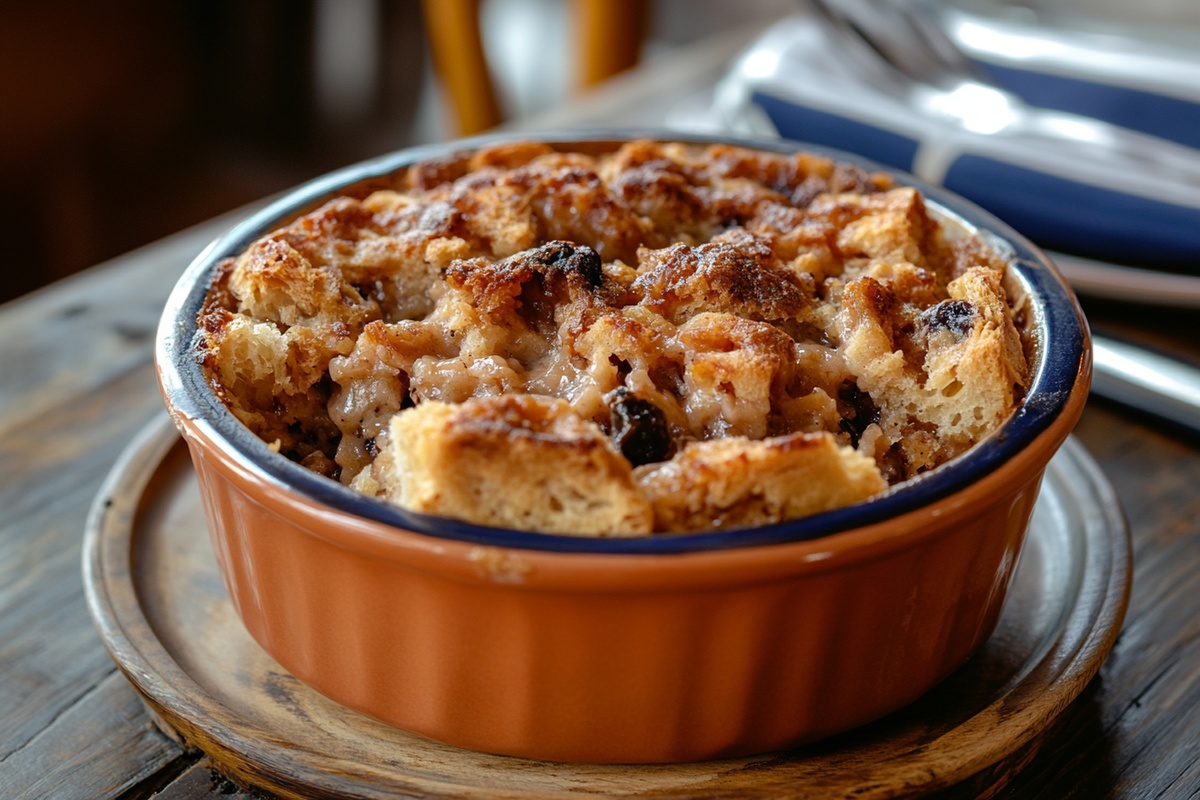
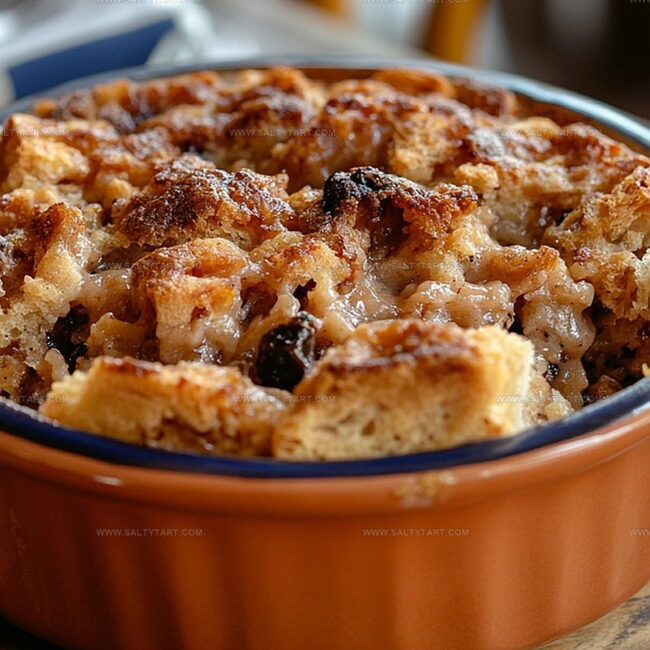
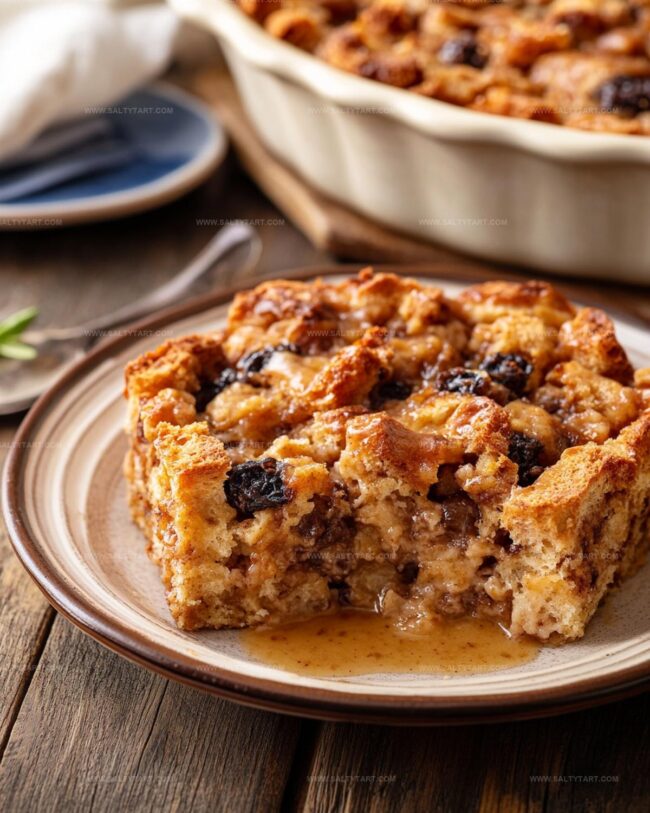
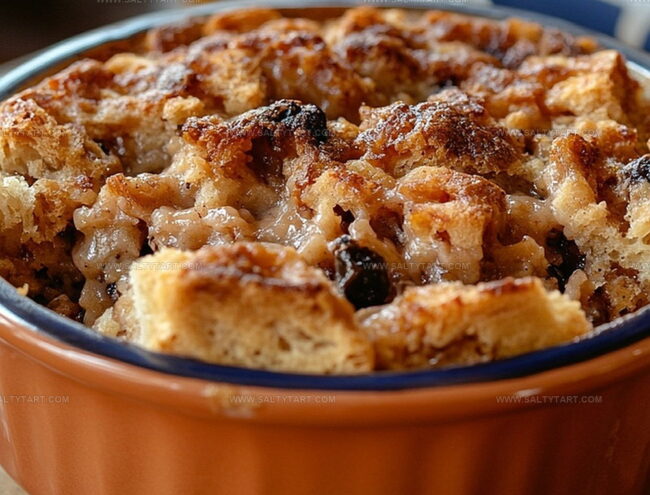
Jess Martinez
Contributing Recipe Writer & Nutrition Consultant
Expertise
Southwestern and Latin American cooking, Nutritional analysis and healthy recipe planning, Cultural food traditions, Modifying traditional dishes for better health
Education
Santa Fe Community College
Certificate in Culinary Arts
Focused on mastering the flavors and cooking methods of traditional Southwestern cuisine.
Jess’s love for bold, homegrown flavors led her straight into the world of Southwestern cooking and cultural nutrition.
After completing her Certificate in Culinary Arts at Santa Fe Community College, she made it her mission to show that good-for-you food can still taste incredible.
At saltytart.com, Jess shares vibrant, health-conscious recipes with roots in tradition but a fresh, modern twist. When she’s not testing new recipes, you’ll find her at local growers’ markets, tending her herb garden, or digging into food history books.